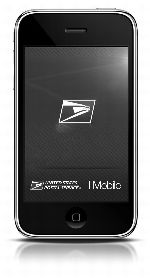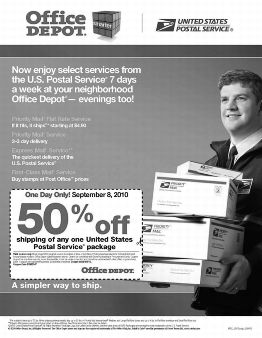The Postal Service’s retail network, already the nation’s most extensive, is becoming more accessible and versatile to reflect changes in technology and customer preference. Consumers and small businesses are the principal users of postal retail, which generated $17.5 billion, or 26 percent of all revenue.
Like all service enterprises, the Postal Service is expanding self-service and online access as it makes ongoing adjustments to its existing retail network to maximize customer convenience while minimizing costs. There is a growing shift in customer transactions away from brick-and-mortar towards online and other forms of self-service, including Click-N-Ship and free Carrier Pickup.
Click-N-Ship, the Postal Service’s online shipping solution, continues to grow in customers and revenue, with Priority Mail Flat Rate shipping the fastest growing segment. Click-N-Ship represents roughly two-thirds of usps.com revenue.
Click-N-Ship features were streamlined to make it easier to use international services. Other changes included security and fraud protection improvements and incorporation of new legal restrictions on the mailing of cigarettes. The Postal Service has also been testing the availability, through Click-N-Ship, of up to $5,000 in optional domestic insurance for Express Mail and Priority Mail (the current limit is $500). The test will be completed this year, at which time the Postal Service will determine if the $5,000 limit will become permanent.
The Postal Store on usps.com is the primary online destination for buying stamps and philatelic products and for ordering free shipping supplies. Online orders comprise almost 72 percent of shipments from the Postal Service’s stamp fulfillment services center in Kansas City, and 69 percent of all orders for expedited shipping supplies.

Customers may also use usps.com to search for available PO Boxes and may pay and manage their box accounts online. 620,469 customers completed PO Box transactions online this year, 44 percent more than last year. Besides being more convenient, the new online option minimizes late payments and unintended box closures.
The Postal Service is engaged in a comprehensive effort to upgrade the underlying technology that supports its online and mobile services and its customer contact centers. This multi-year project will greatly expand online and mobile functionality by making more online services available and by creating a more accessible and intuitive user interface. Improved integration across applications will improve ease of use and allow customer contact center agents to provide consistent personal service.
The first phase, completed this year, streamlined the most frequently used online services: track and confirm (49 percent of site visits); ZIP Code lookup (18 percent); calculate postage (10 percent); and Post Office locator (6 percent). The Postal Service also introduced its free mobile application, which allows customers to track shipments, look up ZIP Codes; and locate nearby Post Offices, Automated Postal Centers and collection boxes, and obtain driving, walking or public transit directions.
Digital postage meters and PC Postage offer convenient postage payment, particularly for customers who mail frequently or in larger volumes. These services make it even easier to print postage and shipping labels and some systems provide detailed postage usage reports for customers and the Postal Service. PC Postage accounted for $1.5 billion in revenue, a 21 percent increase over last year. The number of active users increased by 8 percent.
The postage meter market continued its transition to information-based indicia (IBI) postage. IBI postage meters produce a digital two-dimensional barcode that includes postage payment and other related service information, such as date of mailing, origin and destination ZIP Codes, IBI vendor, mail category, and register values. By year’s end, IBI devices accounted for nearly 78 percent of all postage meters and produced almost 96 percent of postage meter revenue.
PC Postage vendors are participating in pilot trials of an enhanced payment option for package returns. Another pilot program launched this year focuses on PC Postage systems for qualifying federal government entities. These systems provide an alternative to agencies that use postage meters and competitive services for their expedited shipping needs.
PC Postage providers received authorization to allow end-users to generate a single combined shipping, postage, and customs declaration label that also bears an electronic round date. The change gives mailers, including large shippers, greater flexibility for mailing to military and diplomatic addresses, and to U.S. territories and possessions. The Postal Service also began discussions with authorized PC Postage vendors to offer Global Expedited Parcel Shipping discounts using their existing systems rather than requiring the Postal Service global shipping software. This collaborative offering extends postal-tier discounts to more customers.
Healthy growth in shipping services through usps.com is being mirrored with similar growth of PC Postage and eBay. Most notable has been the rapid increase in international services, as more U.S. businesses use the Internet — and postal shipping solutions — to extend their reach to overseas markets.
Customers can create professional direct mail pieces through
usps.com to save time and money with addressing, collating, sorting, and posting. Four services available through partners include Premium Postcards, Click2Mail, CardStore, and Mover’s Postcards. Customers choose a format — postcard, letter, self-mailer, or greeting card — and each mailpiece is personalized, printed, and in the mail the next business day. Customers can also unleash their creativity using Customized Postage, where they can convert their favorite photos into advertising and business logos into real postage.

Postal retail offers convenient local access to mailing and shipping, serving an average of more than 9 million customers each day. Sales at postal retail centers were $12.1 billion, a 4.6 percent reduction from 2009. This year, 30.7 percent of retail revenue was generated by means other than at a postal retail counter, including the self-service Automated Postal Center, usps.com, and sales of stamp booklets by commercial retailers and ATMs. These convenient options supplement access to postal products and expand the times and places where services are available.
This year, 59.2 million fewer customers visited Post Offices (-5.4 percent), continuing a three-year trend in declining customer use. Managers continue to make good use of point of sale transaction data to reduce staff and adapt schedules to the lower customer traffic. In the last three years, retail-related work hours were reduced 19.3 percent while service has improved.
The fixed costs associated with the postal network are more difficult to reduce. Despite steep reductions in customer visits, the number of retail outlets has remained largely unchanged from the time when virtually all postal business was conducted across a counter. The Postal Service will accelerate efforts to modernize its retail network as customer use continues to change and use of usps.com and other self-service options expands.
Partnerships allow the Postal Service to provide access at more convenient times and locations. Available services range from basic — stamp booklets sold at a retailer’s checkout — to full-service mailing and shipping. Retailers who provide postal services gain additional customer traffic. The Postal Service benefits by providing services at relatively low cost with the flexibility to tailor options to local needs.
The Postal Service has sold stamp booklets at thousands of supermarkets, drug stores, and other commercial outlets since the 1980s. Stamps are available at 63,000 such locations. In 2010, this generated $1.2 billion with roughly 14 percent of all stamp booklets sold through this channel. Even so, many customers are unaware of this convenient alternative and make a special trip to the Post Office just to buy stamps. To address this, the Postal Service is working with participating retailers to improve customer awareness and visibility at the point of sale. It is also evaluating changes in the stamps and stamp formats.
Contract postal units (CPUs) provide a wider range of services beyond stamps. Most offer the same basic services available at Post Offices. CPUs are staffed by the host retailer, typically in supermarkets, card and gift shops, colleges, and similar locations. Contracts are specifically tailored to the scope of services offered and the amount of business generated. In 2010, there were 3,720 CPUs in operation. In recent years, the Postal Service has made several changes to improve CPU operations, appearance, financial performance. These efforts are ongoing.
In August, the Postal Service announced a partnership that makes stamps, Express Mail, Priority Mail, and other services available at 1,083 Office Depot stores. Customers pay no fees or surcharges for postal products. The Office Depot partnership is one more example of adapting services to customer needs while finding creative solutions to generate much needed revenue.
Many retailers, typically those offering packaging or private mailbox services, also sell stamps and postal services along with the services of postal competitors. These stores charge customers a service fee in addition to postage and shipping costs. They are not CPUs and receive no fee from the Postal Service. However, the Postal Service does provide limited support to ensure that its products and prices are accurately represented, and that store employees are trained in proper packaging, labeling, and declaration of hazardous materials. The retailer provides that assurance and in exchange is designated as an approved postal provider. The Postal Service also provides basic signage, free Express Mail and Priority Mail packaging, and other limited support.
The Automated Postal Center (APC) is a self-service kiosk that gives convenient access to common postal transactions. Most of the 2,500 APCs are available 24 hours a day, seven days a week in Post Offices. Locations are chosen to maximize customer access and use. APCs generated $577 million, a 5.5 percent increase from last year. The Postal Service continues to explore ways to expand self service, and is currently testing a commercial kiosk that features postage printing and package shipping in 12 commercial retail stores.

